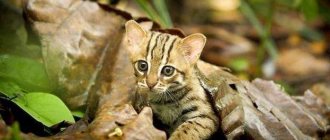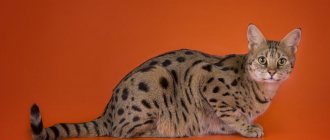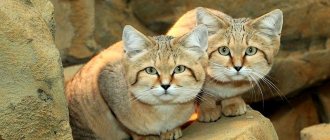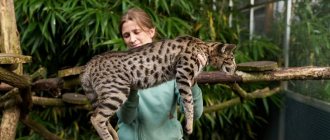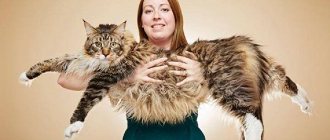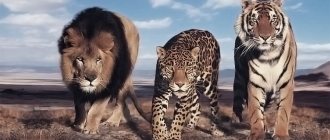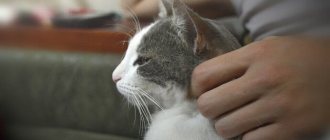Felines are a family of mammals belonging to the order Carnivora. Most often, they get their food by sneaking up and stalking it, sometimes by chasing it.
This family includes many animals, some of which, such as the Amur tiger, are impressive in size and weight. But there are also miniature animals whose weight does not exceed 1 kg.
The smallest wild cats in the world can live in different parts of the planet. But, unlike big cats, they give birth every year or more often, they can give birth to 5 to 6 cubs. This is the only thing that unites them, and their appearance, color, habits and lifestyle can differ significantly.
Each of them has its own unique character, although most eat rodents, are nocturnal and prefer solitude.
Advantages and disadvantages
Despite the fact that yard cats do not have such exclusive characteristics as their purebred counterparts, they are nevertheless not without merit.
- Lasting immunity
. Breeding breeds using selective breeding methods has greatly weakened the immune system of animals. This is why the life expectancy of street cats is many times higher than that of purebred pets. Yard cats have strong protective functions of the body and are able to resist many infections. - Temper
. Such animals tend to be docile in nature. They become very attached to the owner who picked them up on the street. - Reproduction.
Since yard cats do not need a purebred partner, finding a mate for them to reproduce will not be difficult. - Indispensable in the household
. Outdoor cats are excellent mouse hunters. Nature endowed the animal with these qualities, and it is among the domestic representatives of the family that this instinct is much more developed. - Price
. You don't need a big investment to get a pet. You can pick up a cute, albeit not purebred, kitten on the street. Some cats even choose their own owner, coming to visit and “imposing” themselves. - Exhibitions for yard cats
. You heard right. Indeed, there are special exhibitions designed for outbred cats. On them, judges evaluate the external characteristics of the animal and its grooming.
The disadvantages include the inability to make decent money on the offspring of a pet and the excessive sensitivity of non-pedigreed cats. These animals are very sensitive to any changes that occur in their usual habitat. Noisy feasts and even rearrangements in the house can negatively affect the pet.
Today, many pet owners prefer to have yard cats due to their omnivorous nature, ease of care, and strong immunity. It is not entirely correct to call such cats outbred, since all breeds from ancient times originated from wild animals and were subsequently modified depending on their habitat and lifestyle.
Singapore
This type of cat was bred in Singapore, therefore, it has a similar name. This breed is the fourth in the ranking of the most amazing babies of the cat family. Most of her weight is less than three kilograms.
Several decades ago, the first representatives of this breed appeared in the States, and after some time they were brought by breeders to Europe. As for modern times, today these cats are not in very high demand among breeders, and therefore are not very famous and widespread.
Reproduction
Cats gather together between the beginning of January and the end of March. Males in groups begin to hunt for the mother of their future offspring. In addition, the female is often pestered by simply stray cats who also want to mate with her.
Males fight among themselves from time to time. Fights occur both between males of the same species and with outbred cats. But in the end, not all the offspring turn out to be “pure”, since many females manage to mate with outbred males.
When a female becomes pregnant, she begins to look for the best place for the subsequent birth and maintenance of offspring. Cats very often settle in holes and hollows abandoned by their previous owners.
The female brings grass and feathers into the home, thereby making a kind of pillow for her children. She gives birth in 2 months, sometimes a little more time passes, but still the birth occurs in the spring - in April or May. Usually only 2-3 fluffy lumps are born, occasionally 4-5.
Newborn forest kittens are very weak and small, they weigh 200-300 grams. Therefore, the mother has to monitor them and feed them milk.
At the age of a month, babies begin to slowly get comfortable and crawl around the house (at this time the cat should be especially attentive). At two months of age, kittens leave the house and go hunting with their mother. After this, the still small wild kittens begin to try to exist on their own, but their mother does not abandon them.
Sarah – 33 years old
The gray and white cat lived for more than 33 years, gaining fame. She became famous as "New Zealand's Oldest Cat". One can only guess how much her owners loved her. Look how interesting her eyes are, revealing her serious character! Sarah was probably a capricious cat.
Interesting fact: a cat in New Zealand was declared a kleptomaniac - in 2 months she stole at least 60 items of men's underwear. She stored her trophies in the backyard of her master's house. The cat Brigit showed her passion before, when she lived with her owners in another city. I wonder why she was so attracted to things from the men's wardrobe?
Oncilla (lat. Leopardus tigrinus)
One of the most poorly studied cats lives in the mountainous and misty evergreen forests of Central and South America. The name of this predator is translated as “miniature jaguar,” which is quite justified - in all its appearance, oncilla resemble a reduced-sized jaguar.
Oncilla. Photo: Anne-Marie Kalus
Oncillas are only slightly larger than their domestic relatives: an average weight of about 3 kg, body length 65 cm, tail - 30-40 cm. The main difference between the oncilla and other representatives of the genus of tiger cats (Leopardus) is its disproportionately large eyes and ears.
Beautiful soft ocher-colored fur with dark spots played a cruel joke on the animals. In the 1970s and 80s, tens of thousands of oncillas were exterminated as a result of poaching; in 1983 alone, border guards seized 84,000 skins. According to some estimates, over these 20-odd years, 95% of the small jaguar population was destroyed.
Today, any hunting of oncillas is prohibited, as is the sale of any products made from their skin, but the population is nevertheless in no hurry to recover; on the contrary, due to massive deforestation, it is only declining.
Small jaguar in the wild. Photo: Carlos Alfaro
A small jaguar can also be domesticated relatively easily, but in a “gust of passion” the wild nature of the animal can still take its toll - you need to play with the oncilla very carefully
Dwelf
Next in the ranking is such a representative of the cat as Dwelf. As for the main components of this variety, the story is the same as with the Minskin, since the main participants in this process are the Canadian sphinxes and munchkins. As for the main difference, it was achieved thanks to the intervention of such a third breed as the Curl of American origin.
If we consider the basic description of Dwelfs, we can highlight the following distinctive characteristics:
- complete absence of fur;
- the ears are very large and have the shape of elf ears;
- short stature of the breed;
- the eyes have a large round shape with a characteristic bulging;
- a tail similar to that of a rat;
- The weight of representatives of this breed does not exceed three kilograms.
“This feline is very funny and has the appearance of an interesting animal, completely different from a typical cat.”
Dune or desert
Dune (desert) cat
Distribution: North Africa, Arabia, Iran, Southern Morocco and Central Asia. As the name suggests, these cats live in the desert. Ideally adapted to difficult conditions, they are small in size: the body is from 65 cm to 90 cm, and up to 40% is occupied by the tail. The head is short, wide, flattened, with sideburns. They are nocturnal animals that hunt by ear. Therefore, they have very large and wide hearing organs. They don't have tassels. The eyes are yellow in color, very sharp, with a slit-like pupil.
The paws are large and strong. In search of prey, these desert inhabitants travel up to 8 square meters. km per night. There is dense fur on the paw pads, which saves the owner from burns on the hot sand. The color of the Central Asian species is somewhat different from the African one. In summer it is yellowish, and by winter it changes to gray. The fur thickens and lengthens to keep the animal warm in winter frosts.
The main food is birds, rodents, and non-venomous snakes. The main hunting technique is an ambush attack: the victim is grabbed by the neck and shaken violently. A feature of this type of cat is the ability to do without water for a long time: they receive the necessary moisture from food.
The ten largest "wild cats"
• 10 •Eurasian lynx
This is a fairly large “cat”, although smaller than other representatives of the “heavy wild breeds”. Despite the fact that the lynx is a predator, it does not hunt people (moreover, an animal with tufts on its ears and a short tail can even be tamed). The weight of the male is ~29 kg, the female is 23~25 kg. Body length – up to 130 cm.
• 9 •snow leopard
The snow leopard (also known as the snow leopard) lives far from human habitation, so there is no complete information about the animal (their exact numbers are unknown). The body size of the snow leopard is similar to that of the leopard - about 65 cm, and the average weight is ~55 kg.
• 8 •cheetah
The cheetah has thin, long legs and a small skull - for these features the representative is classified as a subspecies of small cats. However, the weight of the animal is an impressive ~65 kg, which indicates a large breed. This mammal has good flexibility and high running speed - it is called the fastest animal in the world. Body length – 115~140 cm, height – 75~90 cm.
• 7 •leopard
This is the most brutal predator, capable of killing prey whose weight is three times its mass - all thanks to its: perfect vision, muscular body, flexibility and high speed. The body length of a leopard depends on its habitat: forest dwellers reach 67 cm in length, and inhabitants of open areas - up to 76 cm. The weight of this hunter is up to 66 kg.
• 6 • cougar
The predator puma has more than 83 names (cougar, red tiger, panther, etc.). These individuals live in mountainous and forest areas of America. Weight – no more than 90 kg. Height – 60~85 cm.
• 5 •jaguar
This is the largest wild cat breed in the United States. The beautiful golden color gives the animal not only a graceful appearance, but also makes it possible to camouflage. The jaguar is one of the best hunters; it is capable of killing its prey with one blow of its paw. Height at withers – 70~80 cm. Weight – 68~135 kg.
• 4 •Bengal tiger
Bengal tigers are one of the largest cat species in the world. They have a striped color and a massive, strong build. The average weight of an adult animal is ~235 kg. The body length of some individuals can exceed 3 m.
• 3 •Amur tiger
I would like to mention Siberian (Amur) tigers separately. They live in the territories of Khabarovsk and Primorsky Krai. In total, there are no more than 500 individuals in the regions. The peculiarity of the breed is its valuable fur. These are very large “cats” (the length of the tail alone reaches about a meter in length): the body size ranges from 1.7 to 2.8 m; height – about 120 cm; weight – 250 kg on average.
• 2 •lion
The peculiarity of the “lion breed” lies in the uniqueness of each representative. There are no two absolutely identical individuals in nature. It is noteworthy that males are not strong at running - therefore, lionesses hunt in the “royal family”. Weight: 160~280 kg (occasionally larger individuals are also found, the record is 313 kg). Height – 100~120 cm. Body length – 1.7~2.5 m.
• 1 •liger
The wild liger breed was created by crossing the tigress Ayla and the lion Arthur. Such a hybrid can only be found in city zoos (the fact is that the natural habitats of tigers and lions are different - reproduction is impossible). The number of such representatives of the cat family is negligible. The liger's height is 186 cm. The weight of the first adult individual was 410 kg. However, later a record weight of a liger was recorded in a park in South Africa - 798 kg.
Outbred champions
The record holder included in the Book of Records is a simple smooth-haired cat, Mr. Pibbles. As an adult male, he weighs only 1.5 kilograms. The length of Mr. Pibbles from the tip of his nose to the base of his tail is 15 cm. The little one lives and lives in the American state of Illinois. According to scientists, the cat's growth slowed down as a result of a congenital genetic mutation.
Mr. Pibbles' main competitor in the fight for the miniature crown is the kitten Heed, who lives in San Diego. The cute baby is 8 centimeters tall and weighs less than a kilogram. But he is still too young to become a record holder.
Another outbred little native of Illinois is the Tinker Toy cat, 18 centimeters long and weighing only 680 grams.
TOP 10 most miniature species of wild cats
The rating is compiled “as it is” (it cannot be said that a person knows all the breeds of wild cats existing in nature).
• 10 •pampas cat
Found in South America, it has a dense build and is similar in color to a leopard. The weight of an adult is up to 8/11 kg (feline/cat), body length is up to 75 cm.
• 9 •jaguarundi
A miniature copy of a jaguar - as the name suggests. They have a flexible body and strong but short legs. Height at withers - up to 35/30 cm (males/females). Weight - up to 9 kg. They are found in a variety of places - savannas, forests, tropics. Secretive animals, but lead a diurnal lifestyle. They feed on small mammals, amphibians, birds, and fish.
• 8 •margay
The “long-tailed cat” (as it is called in its homeland) lives in South and Central America. The body length of this cat is 60~80 cm + 10 tail, and the weight of males reaches 8 kg. Leopardus wiedii leads a solitary nocturnal lifestyle, climbs trees well (and spends most of its life there). In America, hunting cats of the Margay breed is strictly prohibited.
• 7 •forest cat
Felis Silvestris is brown with black stripes. The body is up to 80 cm long (the tail is almost 35 cm), the weight of the cat is up to 6/8 kg, the height at the withers is about 35 cm. They are found mainly in Europe, northern Asia and Africa (African subspecies are the smallest in size).
• 6 • marble cat
Pardofelis marmorata inhabit Southeast Asia. Their body length is less than 55 cm + 50 cm counterweight tail, height is 45~62 cm, and weight is 2~5 kg.
• 5 •Kalimantan cat
Lives near Indonesia and Malaysia. Weight - from 2.3 to 4.5 kg, height less than 40 cm, body length - almost 60 cm. Almost elusive - the cat cannot be photographed in the wild.
• 4 •dune cat
The body length of these cats is from 65 to 90 cm (and almost half of this value is in the tail). The weight of males reaches 3.5 kg, and females - 3 kg. Dune cats live in deserts and rocky valleys and are nocturnal. They seem very cute, even though they are carnivores - they hunt jerboas, spiders, lizards, and insects.
• 3 • “rusty” cat
“Rusty” is its slang name (in Latin the breed sounds like Prionailurus rubiginosus). It became “rusty” because of its characteristic color - a mixture of gray, red, brown colors with an abundance of red spots on the body. It lives in Sri Lanka and southeast India. The height of a “rusty” cat does not exceed 30 cm, length (including tail) - up to 80 cm, weight - from 1.5 to 2 kg. Endangered species (the population is extremely small).
• 2 •Chilean cat
Kodkod (another name for Chilean cats) is an inhabitant of Chile and Argentina. The height at the withers does not exceed 22 cm, weight - from 1.5 to 3 kg, body length - up to 70 cm.
• 1 •black-footed cat
Black-footed cats (Felis Nigripes) have a body length of half a meter, a height of up to 20 cm, and the average weight of an adult is 1.8 kg. But don’t be fooled by the cute eyes and size of this baby - she skillfully hunts birds and rodents, and in captivity becomes very aggressive.
But there are representatives of the cat family so small that they can even be confused with rodents.
Dwarf cat breed Toy Bob
Cats of this breed weigh 2500 kg. Small kittens easily fit in the palm of a child. The main difference from other domesticated representatives is that the hind legs are longer than the front ones. The tip of the ponytail looks like a pompom from a child's hat. Large round blue eyes. The fur on the body and chest is white, and on the legs it is brown. The muzzle is small, triangular in shape.
The animals are brave: they are not afraid of fire and water, they catch rodents, they are friends with dogs and other pets. Owners note that cats of this breed are similar in character to dogs: obedient and easy to train. Toy beans are used to treat children with autism and other health conditions.
The breed was bred in Russia by breeders from the city of Yekaterinburg. The average price for a kitten is 5,000 rubles. If the baby has a rich pedigree (the victories of parents and grandparents in international competitions are taken into account), then the cost increases to 15,000.
Characteristics of servals
A wild cat that becomes a domestic cat leaves behind a funny character. The cat will show it in all its glory, these will be unforgettable years of coexistence between a spotted bush cat and a human.
The animals have not lost their genes anywhere: they happily hang on any ropes, curtains, or cords. The owner's job is to secure the house.
The serval kitten will happily chew on everything that his gaze falls on. To avoid problems with chewed things, the baby is given a sufficient number of toys.
The character of the pet can be called cunning. If he crosses boundaries, this must be stopped. Stop playing if he bites your hand hard at this time. The cat is smart, the correct conclusions will still be drawn.
Since childhood, a kitten has been playing with any cat toys; as they grow older, they are replaced with dog toys; they are larger and will not get into the respiratory tract.
The serval is dexterous and evasive. It's fun to play with him, but if the cat suddenly shows anxiety, you need to be patient. The pet will learn to feel safe with its owner. You can play tug and fetch.
Cats react negatively to the torture that small children may subject them to.
It is important here that the owner does not allow such situations to occur. The pet will remain calm, and no one will scratch the children in fear
If children do not offend the cat, then the relationship with him will be friendly.
This unthreatening predator will most likely be afraid of guests and hide from them. Well, don’t insist, the cat’s healthy psyche is much more important. As soon as the pet gets used to other people's voices and smells, he himself will show curiosity and come out to look at the strangers.
Since in nature cats feed on small rodents, birds and reptiles, and there are already such pets in the house, introductions should be done carefully and gradually. It’s better to think and weigh who you want to keep in the house more
A smart serval will open the latch on the cage with the bird, but not to ask how it is doing. With an affectionate dog that does not chase cats, a good relationship can develop.
It is better to bring a small cat to a house where pets already live. This option will allow you to hope for the emergence of friendship between all the inhabitants of the house or apartment.
Raising and training a pet
To ensure that upbringing goes smoothly, a kitten is purchased no earlier than 1.5 months, but no later than 5 months. It is best to hand feed your baby; this will build trust in the person.
You need to accustom your cute savage to a leash and collar from childhood. At first they offer a loose collar, but gradually tighten it tighter.
Accustom kittens to wood filler in a tray. They will not bury their litter box, so you will have to keep the tray clean. If the cat went to the toilet in a place other than the litter tray, there is no need to scold it. They immediately explain where to go. The animal understands the dissatisfied tone perfectly well.
global $ads_google; //data-ad-slot=”2475549904″ $ads_google = empty($ads_google) ? false : true; ?> if ($ads_google == false) {?>
If your pet climbs onto the table or misbehaves, you can spray it with a water pistol. This will be a serious warning!
The Rusty Cat is the smallest and most adorable wild cat in the world.
Nature is an amazing place where each of us can breathe not only fresh air, but also fully enjoy the sunshine. Nature is also good for your mental health as it reduces stress as well as anger levels. But did you know that nature is also a major source of cuteness?
Yes, yes, because it is in the wild that a huge number of cute creatures live who know how to lift spirits and heal souls.
Forests, jungles, deserts and a number of other natural locations are home to millions of cute animals - koalas, llamas, alpacas, possums, spoders, slow lorises, polar foxes, harp seals and many others.
On this list, of course, is the rusty cat, which, by the way, is also the smallest wild cat on the planet.
Meet the smallest cat on the planet - the rusty cat.
The BBC recently released a preview of its latest episode of Big Cats. It tells the story of an almost adult rusty cat who lives in the wilds of Sri Lanka. The animal wanders through the forest and jumps on the water in search of food and shelter. And these shots are truly amazing!
- The rusty cat (prionailurus rubiginosus) is a wild cat species native to the forests of Sri Lanka and much of India, and has also been rarely found in the Terai and Nepal.
- The graceful wild cat is 35-48 cm long and can easily fit in a human palm.
These tiny creatures are mainly nocturnal, although sometimes they can leave their lair for a short time even during the day. However, their activity during the day is quite limited. These cats often hide among trees and in caves to avoid large predators that might hunt them.
Rodents and birds are what these animals prefer to eat. However, if necessary, they will also attack lizards, frogs and insects.
These small cats can be found in Sri Lanka and India.
What attracts most about these creatures is their small size and fur. This species is also quite often referred to as a smaller version of the leopard, with a reddish coat and smaller, but still present, spots. The body length of the rusty cat is from 35 to 48 cm, the tail length is from 15 to 30 cm. Adult animals weigh only 0.9-1.6 kg.
Like the American bison, black capuchin, rufous lemur and several other wild animals, the rusty cat is also listed as a critically endangered species. The main reason for this is that its natural habitat - deciduous forests - is regularly declining due to human activities and natural causes.
Unfortunately, the rusty cat is on the list of endangered species.
You're probably wondering, who is in second place as the world's smallest cat? And we hasten to answer you - this is a black-footed cat. Despite the fact that this baby is very small, she is credited with the title of the deadliest cat on earth, and all because of her ability to kill more victims than any other feline.
We invite you to watch a short video from the BBC, in which the rusty cat is shown in its natural habitat:
Purebred domestic babies
Singapura: the kitten who will never grow up
Among purebred animals, the Singapura cat confidently holds the palm in terms of miniature size. The pet grows no larger than 3 kilograms (well-fed males can be so heavy), and this is its normal natural state, and not the result of a mutation.
The homeland of the Singapura cat is southern Asia. City cats lived on the streets, in pipes and gutters. Fragile and defenseless creatures were accidentally noticed by an American scientist who visited Singapore 40 years ago. It was he who brought these creatures to the New World and started breeding them. Babies appeared in Russia 20 years ago and immediately became incredibly popular. Today the cost of a purebred kitten reaches $4,000. The authorities of Singapore, having seen such success of previously unwanted cats, hastily declared them national property and banned the free export of individuals outside the state.
The appearance of purebred animals immediately attracts attention with large, expressive eyes. The pussy looks very cute and touching. The Singapura's coat is soft, smooth, and golden-cream in color. The breed's characteristic feature is the almost complete absence of undercoat.
The character of the Thumbelinas fully corresponds to their appearance. Singaporeans are very affectionate, kind, sociable, and balanced. Over the years, the cat begins to understand its owner without words and very subtly sense his mood. Compliant pussies easily get along with other pets. Singapuras do not require special care. The most important thing is to make sure that no one inadvertently offends the baby.
Toy bob: domestic achievement
Worthy competition for imported Singapore cats in the world are our toy beans, or Skif-tay-toy-Dons - the smallest cats bred in Russia. The breed was bred artificially; the name clearly shows who became the “parents” of the baby. The first Toy Bob, a miniature model of a Thai cat, appeared in the Rostov cattery in 1988.
Sexually mature miniature cats look like three-month-old kittens. Their weight rarely reaches 2 kilograms, but they are incredibly smart, strong and kind animals. Excellent immunity protects babies from various misfortunes; toy beans get sick much less often than other cats.
But this breed has earned popular love not only due to its charming fragility; the kittens learn very easily and quickly. The owner never gets bored with his pet, because the baby Toy Bob behaves in many ways like a well-trained dog - these are very smart cats.
The resemblance to a dog adds to the cocky nature of these cats. They are not at all shy, they are not afraid of either loud screams or the sharp claws of their brothers. The toy bob will not yield to any “full-sized” cat in a fight. It is worth saying that in relation to people, animals are very kind, affectionate and do not show the slightest bit of aggression even towards small children.
Munchkin: dachshund cat
If we take the length and weight of the animal as a basis, then we cannot say about munchkins that they are the smallest in the world. Rather, it is the lowest breed. They are slightly larger and heavier than Singaporeans. But their distinguishing feature is their short legs. Outwardly, an adult animal looks like a dachshund, their body appears so squat and elongated.
As for the origin of this small breed, it is a very interesting story. Munchkins were not bred artificially; scientists did not select them. But this type of cat did not previously exist in nature. Cute short legs are the result of a special combination and mutation of the genes responsible for the length of the limbs. Crossed individuals with short legs produced corresponding offspring. This is how the breed spread.
The name “munchkin” (translated as “kangaroo cat”) was given to the unusual animal by the Germans. This idea was prompted by the habit of a short-legged kitty to sit on its butt in a column and carefully look around. In this case, the tail is used as a support, and the front legs hilariously hang along the body - like a kangaroo.
Purrs are peaceful, calm, love to play and spend time with their owner. True, they cannot jump high, but this does not interfere with the fun. Behind the apparent fragility of the cat hides a fighting spirit. Munchkins never give themselves offense and resist any enemy.
Rare cats
golden cat
The golden cat lives in the tropical forests of western and central Africa. The color of its coat is not always golden, but can vary from cinnamon to melanistic color.
They prefer moist, dense forests and can often be found near rivers. They primarily hunt at night and, like most other cats, are loners. Due to the secretive nature of golden cats, they are difficult to spot in the wild.
Kalimantan cat
This wild cat, which is an endangered species, lives on the island of Borneo. Since they are extremely rare, very little is known about them. They are nocturnal and secretive creatures. From 2003 to 2006, scientists set up camera traps to locate these cats, but were only able to obtain one photograph.
Caracal
The name “caracal” comes from the Turkish language “kara-kulak”, meaning “black ear”. These cats hunt at night and often attack animals many times their size, such as antelope.
Sumatran cat
These nocturnal cats live in Thailand and Malaysia, Borneo and Sumatra. They feed mainly on fish and other aquatic animals.
Jaguarundi
These small cats are comfortable in trees but prefer to hunt on the ground in Central and South America.
Chilean cat or Kodkod
The Kodkod is the smallest cat in the Americas and is primarily found in central and southern Chile. The small animal weighs 2 – 2.5 kg and is considered vulnerable. They are excellent climbers and feed on rodents, birds and lizards.
Rusty cat
This cat is found exclusively in India and Sri Lanka and is quite small. Its weight ranges from 900 grams to 1.5 kg. Cats spend most of the day in trees, but they hunt on the ground.
Pampas cat
These cats were named after the pampas of South America. They live in various areas: meadows, bushes and dry forests at an altitude of about 5000 meters. Little is known about their hunting habits, but they have been seen eating rodents and birds and even the occasional domestic game.
Lions and other felines
It probably won’t be a mistake if I say that the most popular wild cat is the lion. No wonder he is called the king of beasts.
The lion lives in Africa and India. Few people know, but in India there is a nature reserve in the state of Gujarat called the Gir Forest. So, in this reserve a small population of Indian lions has been preserved.
Lions are the only cats that permanently live in packs. For example, cheetahs can temporarily unite in small groups, for example three individuals. And lions constantly live in a group; a flock of lions is called a pride.
Of all cats, and perhaps of all predators, lions are distinguished by their mane.
These large cats have pronounced sexual dimorphism. What does it mean? In fact, everything is very simple; among lions, boys and girls are very different from each other, not only internally, but also externally. Lionesses do not have such a lush mane.
Lionesses occupy a subordinate position in the pack. They mainly hunt and the flock depends on lionesses for food
By the way, relations within the pride are very cruel. After all, a lion is a predator.
In the vastness of Africa, the lion's food competitor is the cheetah. The fastest predator is the cheetah. It is capable of reaching speeds of approximately 110 km/h.
Although at such a speed a cheetah is not able to cover long distances, as it gets tired quickly, suddenly making a lightning-fast dash from an ambush is its trump card.
The cheetah, like many wild cats, has very beautiful fur. She also helps him camouflage himself in the bushes and sneak up on his prey unnoticed.
The cheetah's body type is more like a greyhound dog than a cat. And anatomically, the cheetah has many canine characteristics. He even has the character of a dog, he is easily tamed and becomes attached to people.
Servals also live in Africa. Although they are not large, they compete with cheetahs. And they could probably just be their prey.
The serval is a cat with large ears. She loves to live in thickets of small vegetation, which is why she is called a bush cat.
In the bushes of the serval, its color perfectly camouflages it.
Like the cheetah, the serval is tamed. He is even kept in apartments as a pet.
The caracal lives in the deserts of Africa and Asia. Therefore, the caracal is also called the desert lynx, and it looks like a lynx.
The name caracal comes from the Turkish word karakulak, which means “black ear.” Caracals have really black ears.
Despite the external resemblance to the lynx, the caracal is genetically closer to the serval. In captivity, these cats interbreed.
Next, studying the wild cats of Africa, let's turn our attention to the leopard.
Although the leopard is a large predator, it is inferior in size to lions and tigers. And it’s not a little inferior.
The leopard's main habitat is Africa, although it can be found in Asia all the way to China. But only in Africa is its population in normal condition, if this is how one can write about an animal from the Red Book.
So, moving closer to Asia, let’s pay attention to tigers - this is one of the symbols of Asia.
The wild tiger is one of the most formidable predators. They live and hunt solitarily. Only during the mating season can the female and male hunt together.
Now let's move to South America. The largest representative of the cat family here is the jaguar. The jaguar has a magnificent color, somewhat similar to the color of a leopard. Externally, these cats are very similar.
Black jaguars are found in nature. This is not a separate species, but an unusual color variant.
The Indians created legends about these cats, endowing them with mystical abilities.
America's other big wild cat is the cougar. It lives in North America and is a very common predator there.
Puma has many names, other names: cougar, mountain lion, and even red tiger.
Indeed, the puma lives happily in the mountains.
Now let's go back to Europe. Lynx lives here.
The charming forest predator can be tamed and live at home.
The smallest cat in this collection is the Pallas cat. The rare wild cat remains a mystery, largely due to its secretive nature and sparse population. One manul occupies a very large hunting area.
Although its appearance is quite impressive, especially in winter when its thick winter coat makes it appear larger, it is about the size of a regular domestic cat.
Pallas' cats are not tamed. They can live in an enclosure, but they will not become tame animals. Keeping them at home is generally illegal, since the species is endangered and is listed in the Red Book.
Many wild cats are becoming increasingly rare due to population growth. People destroy habitats, food supplies, and simply engage in poaching.
Source: https://komotoz.ru/photo/photo_dikie_koshki.php
History of the origin of yard cats
All cats living next to humans descended from common wild forest and steppe ancestors, which independently became domesticated. For quite a long time it was believed that this happened in ancient Egypt almost four thousand years ago. A painting was discovered on the walls of one of the tombs, which depicts a cat closely watching a rat. However, burials of a person and a cat discovered later in Cyprus are dated to the tenth millennium BC.
In ancient Egypt, cats were considered sacred
Almost all street cats are classified as native breeds, which formed independently naturally under the influence of various conditions in their habitat without any selective intervention from humans.
Quite conventionally, several groups of aboriginal yard domestic cats are distinguished:
- Persian;
- Siamese;
- Turkish Angora;
- European Shorthair (Celtic);
- Siberian
Siamese cats are considered an indigenous breed that formed independently.
The selection of cats with certain exterior characteristics and real selection activities with their breeding began only in the second half of the 19th century. Based on the characteristic features of animals, felinologists formed appearance standards related to a particular breed.
Since then, the gene pool of bred purebred pets, who were not picky in relationships, has been added to the blood of street stray cats and cats living next to humans. Such animals are considered mestizos and are also classified as outbred.
Dune cat
The only wild representative of the cat family that lives in a real desert. The range of the dune cat includes the desert territories of North Africa, the Middle East and Central Asia. With a maximum weight of 3.5 kg and a length of 90 cm, the predator is capable of killing poisonous snakes, for example, vipers. However, it prefers to hunt birds and small mammals.
The sand cat is ideally suited to survive in the desert with its extreme climate. The thick, sandy coat protects the animal from cold desert nights and hides it from larger animals and hunters. And inserts of black hair on the paws protect them from being burned by hot sand. The population of dune cats is not reliably known, however. Despite the cat being listed in Appendix II of the IUCN, it is considered the most protected among wild cats, which TheBiggest editors are very happy about.
Due to its secretive lifestyle, the velvet cat is not easily seen in the wild. To better study the habits of the animal, it is worth going to Western Sahara to the Wise Birding Holidays nature reserve.
7
Jungle cat or marsh lynx, or -haus
Jungle cat (marsh lynx, house)
The range is very large: Asia, Transcaucasia, Dagestan, North Africa, Thailand. Prefers thickets, avoiding open places. This largest wild cat looks like a domestic cat. Length 75 - 125cm. A third is accounted for by a thin and pointed tail, decorated with blackish rings. Hausa weighs up to 15 kg. The limbs of animals are very long. The height ranges from short, like domestic cats in Thailand, to tall, in the Caucasus and Palestine. There are nine species of swamp lynx.
Hunts rodents, hares, pheasants, and young artiodactyls. When hunting waterfowl and small mammals living near water, the Hausa is very helpful in having long legs. They do not allow the fur on the tummy to get wet. In addition, these predators are excellent swimmers, so fish is also included in their diet.
Dwarf minskin
This phenomenon was produced by crossing two varieties of cats, such as the Canadian Sphynx and the Munchkin. The breeding took place in the United States of America.
If we consider the descriptive characteristics of this cat, they boil down to the fact that the animal is not covered with hair at all, has a long body within twenty centimeters, and its weight does not exceed two kilograms, seven hundred grams.
Diet
In nature, the ant tiger's menu includes:
- larks;
- locusts;
- gophers;
- long-eared mice;
- spiders;
- gerbils;
- termites;
- lizards;
- butterflies;
- fresh and dry grass.
Note! If you're lucky, even a bustard, hare or anteater can become prey. During the night, a cat eats up to 300 g of food, and sometimes more.
Scientists recorded that one small predator ate 450g overnight, which was more than a fifth of its weight. This appetite is due to the high metabolic rate
During the night, a cat eats up to 300 g of food, and sometimes more. Scientists recorded that one small predator ate 450g overnight, which was more than a fifth of its weight. This appetite is due to the high metabolic rate.
It is advisable to minimally disturb the natural biorhythms of the ant tiger. There is no need to transfer the animal's activity to the daytime. Therefore, feeding is carried out at night every 40-50 minutes. in small portions. Most of these desert inhabitants prefer meat along with sinews and cartilage tissue. Chicks and quails are given with their feathers. Fresh meat is supplemented with industrial feed and boiled eggs. To create a proper balanced diet, it is better to consult a veterinarian.
Important! It is not advisable to give fish, since it is not part of the predator’s natural diet. After a successful hunt, the animal can bury the prey
After a successful hunt, the animal can bury the prey
